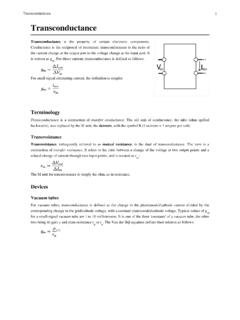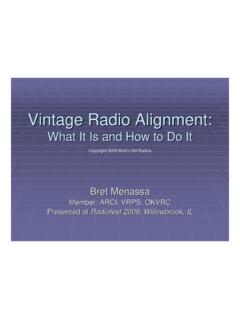Transcription of 1. AMPLIFIERS – INTRODUCTION - SPSJM
1 1. AMPLIFIERS INTRODUCTION AMPLIFIERS are used extensively in electronic circuits to make an electronic signal bigger without affecting it in any other way. Generally we think of AMPLIFIERS as audio AMPLIFIERS in the radios, CD players and stereo s we use around the home. An amplifier , electronic amplifier or (informally) amp is an electronic device that increases the power of a signal. It does this by taking energy from a power supply and controlling the output to match the input signal shape but with a larger amplitude. In this sense, an amplifier modulates the output of the power supply to make the output signal stronger than the input signal. An amplifier is effectively the opposite of an attenuator: while an amplifier provides gain, an attenuator provides loss. The first practical electronic device which could amplify was the Audion (triode) vacuum tube, invented in 1906 by Lee De Forest which led to the first AMPLIFIERS .
2 The terms " amplifier " and "amplification" (from the Latin amplificare, 'to enlarge or expand') were first used for this new capability around 1915 when triodes became widespread. For the next 50 years vacuum tubes were the only devices which could amplify, and were used in all AMPLIFIERS until the 1960s, when transistors began to be used. Most AMPLIFIERS today use transistors, although tubes are still used. Worksheet Exercise 1. Reading Comprehension : Answer the questions. 1. What is an amplifier ? 2. How does an amplifier work? 3. What was the first amplifier called? 4. When and who was it invented by? 5. When did people begin to use transistors? Exercise 2. Complete the highlighted words to the definitions. 1. to enlarge or expand - _____ 2. an increase in wealth or resources - _____ 3. _____ are composed of individual electronic components, such as resistors, transistors, capacitors, inductors and diodes, connected by conductive wires or traces through which electric current can flow.
3 4. The _____of a periodic variable is a measure of its change over a single period (such as time or spatial period). 5. signal that comes out of an electronic system - _____ 6. _____ are devices that control electric current through a vacuum in a sealed container. 7. an electronic device that supplies electric energy to an electrical load - _____ 8. signal going into an electronic system - _____ Exercise 3. Speaking 1. What AMPLIFIERS do you use daily around the home? Name the devices. 2. Do you know any famous amplifier brands? What is your favourite one? 3. What is the brand of your hi-fi audio, car, guitar, etc. amplifier ? 2. SIGNAL A signal as referred to in communication systems, signal processing, and electrical engineering "is a function that conveys information about the behavior or attributes of some phenomenon". In the physical world, any quantity exhibiting variation in time or variation in space (such as an image) is potentially a signal that might provide information on the status of a physical system, or convey a message between observers, among other possibilities.
4 The IEEE (The Institute of Electrical and Electronics Engineers) Transactions on Signal Processing states that the term "signal" includes audio, video, speech, image, communication, geophysical, sonar, radar, medical and musical signals. In electronics, a signal is an electric current or electromagnetic field used to convey data from one place to another. The simplest form of signal is a direct current (DC) that is switched on and off; this is the principle by which the early telegraph worked. More complex signals consist of an alternating-current (AC) or electromagnetic carrier that contains one or more data streams. input signal - signal going into an electronic system (MP3, microphone, ) output signal - signal that comes out of an electronic system (loudspeaker, oscilloscope, another ) Worksheet Exercise 1. Reading Comprehension: Answer the questions. 1. What does a signal convey? 2. What does IEEE stand for?
5 3. What does the term signal include according to the IEEE? 4. What is the definition of a signal in electornics? 5. What does DC and AC stand for? Exercise 2. Name the type of signal (input/output) in these devices: b. _____ c. _____ d. _____ e. _____ Exercise 3. Complete the article with the words from the box. alternating current, signal, circuits, generates, convert, direction, power supply In actuality, the amplifier 1. _____ a completely new output signal based on the input signal. You can understand these signals as two separate 2. _____ The output circuit is generated by the amplifier 's 3. _____, which draws energy from a battery or power outlet. If the amplifier is powered by household 4. _____, where the flow of charge changes directions, the power supply will 5. _____ it into direct current, where the charge always flows in the same 6. _____. The power supply also smoothes out the current to generate an absolutely even, uninterrupted 7.
6 _____. The output circuit's load (the work it does) is moving the speaker cone. 3. TRANSISTORS Transistors are the semiconductor devices with three terminals. The three terminals are called emitter, collector and base. Transistor is operated in three configurations called as common base, common emitter and common collector. Transistor is used for voltage and current amplification according to configurations. At base input signal of small amplitude is given and magnified output signal is collected at collector. Thus transistors help in achieving amplification of signal. By passing input current signal from region of low resistance to region of high resistance amplification is achieved in transistors. Transistors of two types: Unipolar junction transistor Bipolar junction transistor UNIPOLAR JUNCTION TRANSISTOR The current condition in unipolar transistor is due to only one type of charge carriers, majority carriers.
7 The field-effect transistor (FET) is a transistor that uses an electric field to control the shape and hence the electrical conductivity of a channel of one type of charge carrier in a semiconductor material. FETs are also known as unipolar transistors as they involve single-carrier-type operation. The FET has several forms, but all have high input impedance. While the conductivity of a non-FET transistor is regulated by the input current (the emitter to base current) and so has a low input impedance, a FET's conductivity is regulated by a voltage applied to a terminal (the gate) which is insulated from the device. The applied gate voltage imposes an electric field into the device, this in turn attracts or repels charge carriers to or from the region between a source terminal and a drain terminal. The density of charge characters in turn influences the conductivity between the source and drain. The FET's three terminals are: Source (S), through which the carriers enter the channel.
8 Conventionally, current entering the channel at S is designated by IS. Drain (D), through which the carriers leave the channel. Conventionally, current entering the channel at D is designated by ID. Drain-to-source voltage is VDS. Gate (G), the terminal that modulates the channel conductivity. By applying voltage to G, one can control ID. BIPOLAR JUNCTION TRANSISTOR In bipolar transistor the current condition is due to both types of charge carriers, holes and electrons. So it is called bipolar. It is also referred as BJT. These two kinds of charge carriers are characteristic of the two kinds of doped semiconductor material; electrons are majority charge carriers in n-type semiconductors, whereas holes are majority charge carriers in p-type semiconductors. In contrast, unipolar transistors such as the field-effect transistors have only one kind of charge carrier. NPN is one of the two types of bipolar transistors, consisting of a layer of P-doped semiconductor (the "base") between two N-doped layers.
9 The other type of BJT is the PNP, consisting of a layer of N-doped semiconductor between two layers of P-doped material. CONSTRUCTION OF BJT: If a p-region is sandwiched between two n-regions like shown in figure(a), then its n-p-n transistor. a. If a n-region is sandwiched between two p-regions like shown in figure(b), then its p-n-p transistor. b. PARTS OF TRANSISTORS 1. BASE- It is the middle region of the transistor. It is lightly doped and it is very thin. 2. EMITTER AND COLLECTOR- These are the other two regions of transistors. These regions are heavily doped. Emitter s doping level is slightly greater than that of collector and collector region-area is Worksheet Exercise 1. What types of transistors can you see in the pictures ? What do the letters stand for? Write the words. a. _____ G = _____ C = _____ D = _____ E = _____ S = _____ b. _____ B = _____ C = _____ E = _____ NPN = _____ PNP = _____ Exercise 2.
10 Decide if the statements are true or false. Correct the false statements. 1. FETs are also known as bipolar transistors. 2. The carriers leave the channel through GATE. 3. In bipolar transistor the current condition is due to both types of charge carriers, holes and electrons. 4. Majority charge carriers in n-type semiconductors are holes, whereas majority charge carriers in p-type semiconductors are electrons. 5. BASE is the middle region of the transistor which is heavily doped and it is very thick. 6. If a p-region is sandwiched between two n-regions then its n-p-n transistor. 4. Classification of AMPLIFIERS There are many forms of electronic circuits classed as AMPLIFIERS , from Operational AMPLIFIERS and Small Signal AMPLIFIERS up to Large Signal and Power AMPLIFIERS . The classification of an amplifier depends upon the size of the signal, large or small, its physical configuration and how it processes the input signal, that is the relationship between input signal and current flowing in the load.



